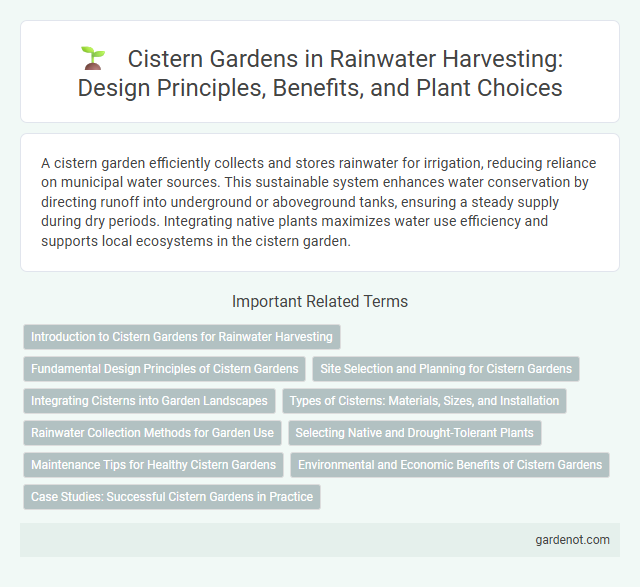A cistern garden efficiently collects and stores rainwater for irrigation, reducing reliance on municipal water sources. This sustainable system enhances water conservation by directing runoff into underground or aboveground tanks, ensuring a steady supply during dry periods. Integrating native plants maximizes water use efficiency and supports local ecosystems in the cistern garden.
Introduction to Cistern Gardens for Rainwater Harvesting
Cistern gardens integrate rainwater harvesting systems that capture and store runoff for irrigation, improving water conservation in arid and urban environments. These gardens often use underground or above-ground tanks to collect rainwater from rooftops, reducing dependency on municipal water supplies. By optimizing water use through smart design and native plants, cistern gardens enhance sustainability and promote environmental resilience.
Fundamental Design Principles of Cistern Gardens
Cistern garden design focuses on maximizing rainwater capture and storage through strategically placed cisterns, ensuring efficient irrigation during dry periods. Key principles include using impermeable liners to prevent water loss, integrating overflow systems to manage excess rainwater, and selecting appropriate plant species that thrive with stored water supply. Proper slope grading and filtration methods are essential to maintain water quality and optimize garden sustainability.
Site Selection and Planning for Cistern Gardens
Selecting an optimal site for a cistern garden involves assessing soil permeability, sun exposure, and proximity to water collection points to maximize rainwater capture and plant growth. Proper planning includes designing the cistern capacity based on local rainfall patterns and garden water needs, ensuring efficient irrigation and sustainable water use. Incorporating elevation and slope considerations helps facilitate gravity-fed water flow, reducing reliance on pumps and improving overall system efficiency.
Integrating Cisterns into Garden Landscapes
Cisterns can be seamlessly integrated into garden landscapes by using them as both functional water storage and aesthetic features, such as incorporating them into raised beds or decorative planters to enhance visual appeal. Positioning cisterns strategically allows for efficient rainwater capture while supporting irrigation needs for drought-tolerant plants and edible gardens. This approach not only conserves water but also promotes sustainable gardening practices by reducing reliance on municipal water sources.
Types of Cisterns: Materials, Sizes, and Installation
Cistern gardens utilize various types of cisterns made from materials such as concrete, fiberglass, polyethylene, and steel, each offering different durability and maintenance levels. Sizes range from small 50-gallon tanks suitable for residential gardens to large 5,000-gallon systems designed for extensive irrigation, ensuring scalability based on water storage needs. Installation methods vary from above-ground setups for easy access and monitoring to underground systems that optimize space and prevent algae growth.
Rainwater Collection Methods for Garden Use
Cistern gardens utilize large, durable tanks to collect and store rainwater from rooftops and surface runoff, ensuring a sustainable water source for irrigation. These systems often incorporate filtration techniques to remove debris and pollutants, optimizing water quality for plant health. Efficient rainwater collection methods reduce dependence on municipal water, promoting eco-friendly garden maintenance and conservation.
Selecting Native and Drought-Tolerant Plants
Selecting native and drought-tolerant plants for cistern gardens enhances water conservation by reducing irrigation needs and increasing resilience to local climate conditions. These plants adapt well to harvested rainwater's variable supply, promoting sustainable landscaping and minimizing maintenance costs. Incorporating species such as sage, lavender, and yucca supports biodiversity and ensures long-term garden vitality under water-limited scenarios.
Maintenance Tips for Healthy Cistern Gardens
Regularly inspect and clean cistern filters and gutters to prevent debris buildup and ensure efficient rainwater flow. Monitor water quality by checking for algae growth and maintaining proper pH levels, using natural treatments if necessary. Trim surrounding vegetation to minimize leaf litter and schedule periodic maintenance to sustain healthy plant growth in cistern gardens.
Environmental and Economic Benefits of Cistern Gardens
Cistern gardens significantly reduce reliance on municipal water by capturing and storing rainwater, promoting sustainable water management and lowering overall water consumption. These gardens enhance soil moisture retention, reducing irrigation needs and preventing soil erosion, which supports healthier plant growth and biodiversity. Economically, they decrease water bills and mitigate stormwater runoff costs, making cistern gardens a cost-effective and eco-friendly solution for urban and suburban landscapes.
Case Studies: Successful Cistern Gardens in Practice
Successful cistern gardens demonstrate practical rainwater harvesting by efficiently capturing and storing runoff for irrigation, reducing urban water demand by up to 50%. Case studies in cities like Tucson, Arizona reveal that well-designed cistern systems support diverse plant species while minimizing water waste. These projects highlight sustainable landscape management, improve drought resilience, and enhance local biodiversity through optimized water reuse.
Cistern garden Infographic

 gardenot.com
gardenot.com